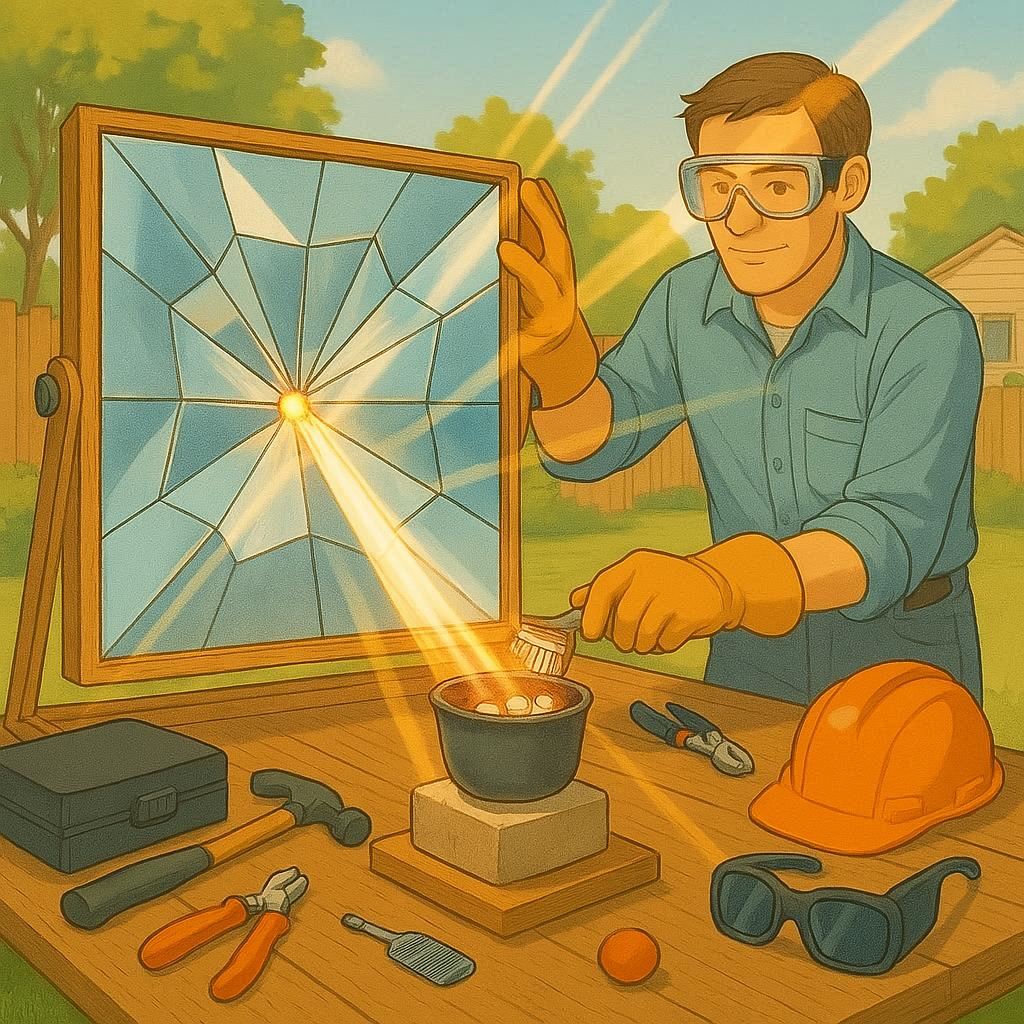Melting Metals with Sunshine: Building a Solar Furnace at Home
Introduction
The sun is an extraordinary source of energy, and harnessing its power can be both fascinating and functional. One of the most intriguing ways to tap into solar energy is by building a solar furnace, a device capable of reaching high temperatures using nothing but sunlight. In this blog post, we’ll explore how to build a solar furnace at home, allowing you to melt metals, recycle materials, or even craft unique metalwork projects using the power of the sun.
Understanding How a Solar Furnace Works
Before we dive into the construction process, it’s essential to understand how a solar furnace operates. A solar furnace captures and concentrates sunlight onto a specific area, generating intense heat. This concentration is achieved through the use of reflective surfaces that redirect sunlight to a focal point. The heat is then absorbed and retained, allowing you to reach temperatures high enough to melt certain metals.
Key Components of a Solar Furnace
- Reflective Surface: This is the heart of your solar furnace. A reflective material, such as aluminum foil or a mirror, is used to redirect sunlight to the focal point.
- Focal Point: The focal point is where the concentrated sunlight is directed. This is where your metal will be placed to melt.
- Insulation: To maintain the high temperatures required for melting metal, insulation is crucial. Materials like foam board or ceramic fiber blanket can be used to retain heat.
- Container: The container holds the insulation and focal point together. It can be made from materials like wood or metal, depending on your design.
Materials Needed
To build a basic solar furnace, you’ll need the following materials:
- A sturdy wooden box or metal container
- Reflective material (aluminum foil, mirrors, or polished metal sheets)
- Insulating material (foam board, ceramic fiber blanket, or straw)
- Glass or clear plastic for the top
- A small metal crucible or container for melting
- Metal scraps or small metal items to melt
- Glue or adhesive for assembly
- Scissors, knife, or saw for cutting materials
- A ruler or measuring tape
- A pencil or marker
- A thermometer (optional)
- Safety goggles and heat-resistant gloves
Step-by-Step Construction Guide
- Design the Container: Start by designing the container that will house your solar furnace. The size will depend on the scale of your project, but a larger container will generally capture more sunlight. If you’re using a wooden box, ensure it is sturdy and well-constructed.
- Line the Container with Reflective Material: Cover the inside of the container with your reflective material. This will help direct sunlight to the focal point. Aluminum foil is an inexpensive and effective option, but mirrors or polished metal sheets will provide greater reflectivity.
- Create the Focal Point: At the center of the container, create a small area where the concentrated sunlight will be directed. This is where you’ll place your metal for melting. If you’re using a crucible, position it in this spot.
- Add Insulation: Line the sides and bottom of the container with insulating material. This will help retain the heat generated by the focused sunlight. If using straw, pack it tightly around the crucible and within the container.
- Cover with Glass or Clear Plastic: Place a layer of glass or clear plastic over the top of the container. This will trap heat and protect the interior from the elements. If you’re using glass, ensure it’s heat-resistant to prevent shattering.
- Assemble the Furnace: Put all the components together, ensuring the reflective material is securely in place and the insulation is evenly distributed. If needed, use glue or adhesive to hold the materials in position.
- Test the Furnace: Before attempting to melt metal, test the furnace by placing a small object, like a piece of paper or a dry leaf, at the focal point. Use a thermometer to measure the temperature reached. If the temperature isn’t high enough, consider adjusting the angle of the reflective material or adding more insulation.
- Safety Precautions: Always wear safety goggles and heat-resistant gloves when operating the solar furnace. Ensure the area is well-ventilated, and keep flammable materials away from the furnace. Never leave the furnace unattended while it’s in use.
Practical Tips for Optimal Performance
- Adjust the Angle: The angle at which you position the reflective material can significantly impact the performance of your solar furnace. Experiment with different angles to find the one that directs the most sunlight to the focal point.
- Use a Tracking System: To maximize the amount of sunlight your solar furnace receives, consider building a simple tracking system that adjusts the position of the furnace throughout the day. This can be as simple as a manually adjustable stand or as complex as a motorized tracking system.
- Monitor the Temperature: If you have a thermometer, use it to monitor the temperature at the focal point. Most metals have specific melting points, so knowing the temperature will help you determine when it’s ready to melt.
Projects You Can Work On
Once your solar furnace is operational, there are a number of exciting projects you can undertake:
- Recycling Metals: Use your solar furnace to melt down scrap metal and recycle it into new items. For example, you could melt down aluminum cans and cast them into small ingots or shapes.
- Metal Casting: Experiment with metal casting by melting small metal objects and pouring the molten metal into molds. You can create unique jewelry, decorative items, or even functional tools.
- Heat Treating: Some metals can be heat-treated to alter their properties, such as hardness or flexibility. Use your solar furnace to perform basic heat-treating processes on metal objects.
- Scientific Experiments: If you’re interested in science, you can use your solar furnace to conduct experiments on the properties of heat, light, and materials. For example, you could explore how different materials react to high temperatures or how the angle of the reflective surface affects the focal point temperature.
Environmental Benefits
Building and using a solar furnace is not only a fun and educational project, but it also has environmental benefits. By using solar energy, you’re reducing your reliance on non-renewable energy sources and lowering your carbon footprint. Additionally, recycling metals using your solar furnace can help reduce the need for new metal production, which is often energy-intensive and environmentally damaging.
Conclusion
Building a solar furnace at home is a rewarding project that allows you to harness the power of the sun to melt metals and create unique items. With a few simple materials and some basic tools, you can construct a functional solar furnace capable of reaching high temperatures. Whether you’re interested in recycling, metalworking, or simply exploring the properties of solar energy, this project offers a hands-on way to learn and create. So, gather your materials, get outside, and start melting metals with sunshine!



